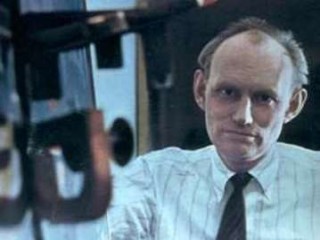
Billy Klüver biography
Date of birth : 1927-11-13
Date of death : 2004-01-11
Birthplace : Monaco
Nationality : American
Category : Science and Technology
Last modified : 2011-12-19
Credited as : Engineer, Ordre des Arts et des Lettres award, founded Experiments in Art and Technology
0 votes so far
He published numerous articles on these subjects. Klüver curated (or was curatorial adviser) for fourteen major museum exhibitions in the United States and Europe. He has received the prestigious Ordre des Arts et des Lettres award form the French government.
Klüver was born in Monaco, November 13, 1927, and grew up in Sweden. He graduated from the Royal Institute of Technology, Stockholm, in Electrical Engineering. In 1952, at age 25, working for a large electronics company in France, Klüver helped install a television antenna on top of the Eiffel Tower and devised an underwater TV camera for Jacques Cousteau's expeditions.
In 1954 he came to the United States and received a Ph.D. in Electrical Engineering from the University of California, Berkeley in 1957. He served as Assistant Professor of Electrical Engineering, at the University of California, Berkeley, 1957–58 and from 1958 to 1968 he was a Member of Technical Staff at Bell Telephone Laboratories in Murray Hill. He published numerous technical and scientific papers on, among others, small signal power conservation in electron beams, backward-wave magnetron amplifiers and infra-red lasers. He holds 10 patents.
In the early 1960s, Klüver began to collaborate with artists on works of art incorporating new technology, the first being kinetic art sculptor Jean Tinguely on his "Homage to New York" (1960), a machine that destroyed itself that was presented in the garden at MOMA. He was introduced to Jean Tinguely by Pontus Hulten, then director of the Moderna Museet, Stockholm. Robert Rauschenberg also assisted on "Homage to New York".
Klüver then worked on Robert Rauschenberg’s environmental sound sculpture called "Oracle"; and later with Yvonne Rainer on her dance In "House of my Body". Klüver also worked with John Cage and Merce Cunningham on their "Variations V", with Jasper Johns, inserting battery powered lights into a painting, and with Andy Warhol on "Silver Clouds". Another ambitious project of that period was a collaboration on Rauschenberg's "Mud Muse", a massive installation containing liquid mud activated by sound. The piece appeared in the L.A. County Museum's "Art and Technology" show of 1971; along with three other Rauschenberg-Klüver collaborations.
Klüver, Fred Waldhauer and artists Robert Rauschenberg and Robert Whitman collaborated in 1966 organized 9 Evenings: Theatre and Engineering, a series of performances that united artists and engineers. The performances were held in New York City's 69th Regiment Armory, on Lexington Avenue between 25th and 26th Streets as an homage to the original and historical 1913 Armory show. Ten artists worked with more than 30 engineers to produce art performances incorporating new technology.
In 1966 Klüver, Robert Rauschenberg, Robert Whitman, and Fred Waldhauer founded Experiments in Art and Technology, a not-for-profit service organization for artists and engineers. Since 1968 he served as president of Experiments in Art and Technology.
E.A.T. established a Technical Services Program to provide artists with technical information and assistance by matching them with engineers and scientists who can collaborate with them. In addition. E.A.T. initiates and administers interdisciplinary projects involving artists with new technology.
In 2001 Klüver produced an exhibition of photo and text panels entitled "The Story of E.A.T.: Experiments in Art and Technology, 1960 - 2001 by Billy Klüver." It was first shown in Rome, then at Sonnabend Gallery in January 2002. The exhibition went to Lafayette College in the spring 2002, then to the Evolution Festival in Leeds, England, and University of Washington, in Seattle. In 2003 it traveled to San Diego State University in San Diego, California and then to a gallery in Santa Maria, California, run by Ardison Phillips who was the artist who managed the Pepsi Pavilion in 1970.
From April to June 2003 a Japanese version was shown at a large exhibition at the NTT Intercommunication Center (ICC) in Tokyo which also included a number of object/artifacts and documents and E.A.T. posters, as well as works of art that Klüver and E.A.T. were involved in. A similar showing took place in Norrköping Museum of Art, Norrköping, Sweden in September 2004 and a small version was presented in 2008 at Stevens Institute of Technology.
















